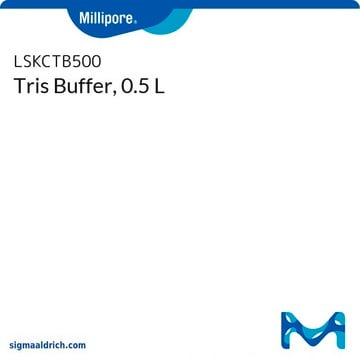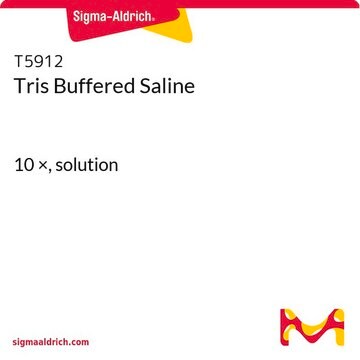21685
ATX Tris buffer
ready-to-use solution
Se connecterpour consulter vos tarifs contractuels et ceux de votre entreprise/organisme
About This Item
Beilstein:
3535773
Numéro MDL:
Code UNSPSC :
12161700
ID de substance PubChem :
Nomenclature NACRES :
NA.25
Produits recommandés
Chaîne SMILES
NC(CO)(CO)CO
InChI
1S/C4H11NO3/c5-4(1-6,2-7)3-8/h6-8H,1-3,5H2
Clé InChI
LENZDBCJOHFCAS-UHFFFAOYSA-N
Vous recherchez des produits similaires ? Visite Guide de comparaison des produits
Conditionnement
6 bottles for the preparation of 1 L ready-to-use solution (each)
Code de la classe de stockage
10 - Combustible liquids
Classe de danger pour l'eau (WGK)
WGK 1
Point d'éclair (°F)
Not applicable
Point d'éclair (°C)
Not applicable
Équipement de protection individuelle
Eyeshields, Gloves
Faites votre choix parmi les versions les plus récentes :
Déjà en possession de ce produit ?
Retrouvez la documentation relative aux produits que vous avez récemment achetés dans la Bibliothèque de documents.
Les clients ont également consulté
Seong H Chow et al.
Journal of leukocyte biology, 108(3), 967-981 (2020-06-13)
Staphylococcus aureus causes necrotizing pneumonia by secreting toxins such as leukocidins that target front-line immune cells. The mechanism by which leukocidins kill innate immune cells and trigger inflammation during S. aureus lung infection, however, remains unresolved. Here, we explored human-induced
Timothy J Kidd et al.
Journal of clinical microbiology, 47(5), 1503-1509 (2009-03-06)
Pseudomonas aeruginosa is an important cause of pulmonary infection in cystic fibrosis (CF). Its correct identification ensures effective patient management and infection control strategies. However, little is known about how often CF sputum isolates are falsely identified as P. aeruginosa.
Sean Ekins et al.
Drug metabolism and disposition: the biological fate of chemicals, 38(12), 2302-2308 (2010-09-17)
Drug-induced liver injury (DILI) is one of the most important reasons for drug development failure at both preapproval and postapproval stages. There has been increased interest in developing predictive in vivo, in vitro, and in silico models to identify compounds
Nigel Greene et al.
Chemical research in toxicology, 23(7), 1215-1222 (2010-06-18)
Drug-induced liver injury is a major issue of concern and has led to the withdrawal of a significant number of marketed drugs. An understanding of structure-activity relationships (SARs) of chemicals can make a significant contribution to the identification of potential
Zhichao Liu et al.
PLoS computational biology, 7(12), e1002310-e1002310 (2011-12-24)
Drug-induced liver injury (DILI) is a significant concern in drug development due to the poor concordance between preclinical and clinical findings of liver toxicity. We hypothesized that the DILI types (hepatotoxic side effects) seen in the clinic can be translated
Notre équipe de scientifiques dispose d'une expérience dans tous les secteurs de la recherche, notamment en sciences de la vie, science des matériaux, synthèse chimique, chromatographie, analyse et dans de nombreux autres domaines..
Contacter notre Service technique



